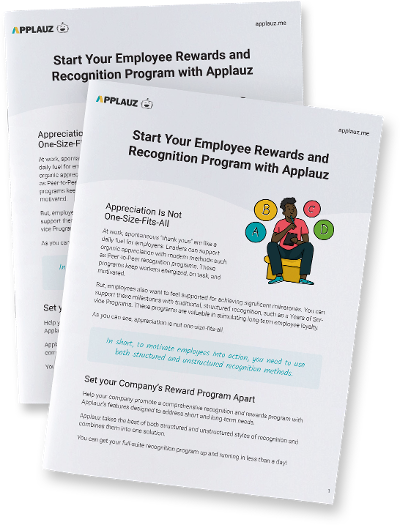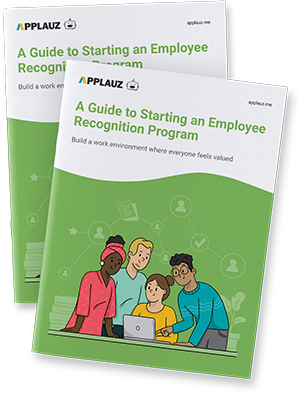Imagine only getting words of appreciation from your friends and family on your birthday.
How would such sparse gratitude make you feel?
First off, you would certainly look forward to your birthday. You would also feel neglected the other 364 days of the year.
The desire to feel acknowledged is a basic human need. As such, most people relish getting frequent positive words of appreciation from their friends and loved ones.
Appreciation at work
The power of gratitude applies in our personal lives, but also our work life.
As a case in point, many companies have in place some variant of a recognition program. Frequently, taking the form of a Years of Service Program.
But, many leaders put these programs in place and wonder why they don’t solve their most crucial HR problems.
Formal recognition programs are a good starting point. Still, a singular recognition method cannot be applied as a universal remedy for all management issues.
Recognition is not one-size-fits-all
Human motivation is complex. A blend of short-term and long-term needs inspires people into action. 
That said, appreciation and praise are a fundamental part of the employee motivation puzzle. But recognition comes in all shapes and sizes. In short, there are so many reasons to give employees recognition.
Some gestures of recognition boost short-term motivation. In contrast, others are better at promoting long-term commitment. In other words, recognition is not one-size-fits-all.
Ultimately, one singular recognition program cannot solve all your people management issues. A more nuanced approach is needed.
We'll start simple — breaking down recognition methods into two main types. You will see why one sort of recognition is a good start, but not enough for capturing the full benefits of appreciation.

Do your managers struggle to give recognition?
Upskill your leaders and discover proven best practices for recognition with our Recognition Training for Managers.
 2 Main Types of Employee Recognition
2 Main Types of Employee Recognition
If you analyze the most common employee recognition strategies offered by top businesses, it becomes clear that all these methods fall neatly into two categories.
- Structured
- Unstructured
We will go over these two categories to understand why each is fundamental to driving long-term and short-term employee motivation.
Structured
Structured methods are more traditional. These programs often take a top-down approach. Meaning, senior leaders or HR offer gratitude to employees on behalf of the company.
We label these programs “structured” as they are official and ceremonial. They are ![]() expected and happen at predictable times.
expected and happen at predictable times.
Some examples of these programs are:
- Years of Service Awards
- Yearly merit raises
- The employee of the month
- Employee nomination programs
- Employee award programs
- Retirement
Structured methods are the foundation of a culture of recognition. These predictable, ritual celebrations create a feeling of belonging.
Predictable recognition celebrations enrich company culture. As a case in point, a 2017 World at Work study showed that 85% of companies offered a length of service program.
Structured methods are excellent at addressing long-term employee needs. These recognition initiatives incentivize and sustain deeper employee motivation.
For example, celebrating work anniversaries is an important way to communicate that your business values employee dedication. In short, predictable recognition is an excellent way to provide employees direction, meaning, and purpose.
Benefits of structured recognition
- Expected + formal: Structured recognition gives employees something to look forward to, and its formal nature gives recognition more weight.
- Organizationally driven: Recognition is usually given on behalf of the organization.
- Fair + inclusive: For most structured programs, every employee is included (or at least has an opportunity to be) and therefore can get recognized.
- Drives long-term dedication: A traditional recognition program is an excellent tool for making employees feel valued on a long-term basis.
Drawbacks of structured recognition
- Infrequent: Employees have to wait long stretches of time for recognition.
- Impersonal: Recognition is not usually not tied to specific achievements or skills, and if everyone receives the same gift or trophy, recognition risks feeling impersonal.
- Budget needed: Structured recognition programs often involve plaques, trophies, or gifts, which requires a budget.
 Unstructured
Unstructured
Unstructured recognition is a relatively new concept. But it’s quickly becoming a popular employee recognition method. Companies understand the importance of regular praise for employees to feel valued at work.
In these modern recognition practices, leaders intentionally create space for spontaneous gestures of appreciation.
Coworkers are encouraged to offer each other recognition. Praise is not something only managers give to employees.
Unstructured methods can take many forms; they can be inexpensive to administer or need a small budget. An example is an email recognizing the top performers of the week, a recognition channel on a chat tool, or a budget distributed to reward employees for accomplishing necessary tasks.
Some examples of these recognition programs are:
- Peer-to-peer recognition
- Continuous recognition (points-based system)
- Performance incentive programs
- The celebration of life milestones
That said, technology has stepped up to help companies with this method of appreciation. In essence, digital tools help make impromptu recognition more official.
For example, software like Applauz Recognition provides a platform where employees can post messages of recognition for their peers on a company Newsfeed.
The goal is to weave appreciation into daily life. As a result, employees feel valued all year round.
Benefits of unstructured recognition
- Flexible & frequent: Recognition is timely. Employees don’t have to wait for a formal event to get praise.
- From manager: Praise comes directly from a manager, so it feels more personal.
- Personalized: Employees are praised for specific skills and accomplishments — so workers feel special.
- Peers can be involved: Informal programs allow employees to receive praise from coworkers.
- Drives short-term performance: Consistent gratitude helps boost daily morale and keep short-term motivation on track.
- Affordable: Unstructured programs can be inexpensive to deliver, if not completely free.
Drawbacks of unstructured recognition
- Perceived favouritism: Inadvertently, managers may recognize only a few people, causing feelings of favouritism. However, this is easy to avoid when managers make an effort to recognize different types of actions and people.
- Learning curve: Getting into the habit of giving regular recognition can take some time. Especially if a recognition platform supports this objective. It may take time for managers and workers to adopt a new digital tool.
Start Your Employee Rewards & Recognition Program with Applauz
Are You Attaining Your HR Goals?
A 2017 World at Work study asked organizational leaders, "What are the objectives/goals of your organization's recognition programs?"
A few of the most common responses:
- Recognize years of service
- Create a positive work environment
- Create a culture of recognition
- Motivate high performance
- Reinforce desired behaviours
- Support organizational mission/values
- Increase morale
Think about the current recognition methods being used in your company. Are they fulfilling your HR goals? If not, it might be time to include other recognition methods into your strategy.
Bottom line: A company cannot achieve these goals with a single type of recognition method. A mix of unstructured and structured recognition is required to meet different employee needs and achieve long-term HR goals.
About the author
 Michelle Cadieux
Michelle Cadieux
Michelle is a content writer for Applauz. She holds a Bachelor's degree in Psychology from Concordia University, and she has been writing about work and employee happiness for over five years.



